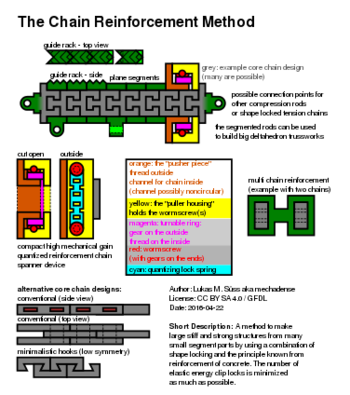ReChain Frame System
Shape locking
The sub-problem-1: How to replace tiny metal screws with medium sized printed parts? Note: Clipping is taboo too. It is too weak for a serious design.
The sub-solution-1: To get rid of all the tiny screws all pieces are locked together merely by their shape. If the tolerances are kept very generous for easy "fall-in-assembly" even a bad RepRec can do the job.
Reinforcement
The sub-problem-2:
Now this method alone obviously makes ridiculously sloppy connections - almost like a piece of cloth.
So how to replace giant monolithic structural rods with rods out of mutually interlocked medium sized parts without getting a useless jelly-like meta structure?
The sub-solution-2:
Stiffness in a structural framework can be archived through reinforcement very similar to the pre-tensioned rebars in concrete. For RepRecs this works by pulling on chains whichs segments are connected by shape locking alone and are spanned within the tubes that go through a big number of stacked short segments of profile struts. It can be a single chain or more for a bigger profile (e.g. 3). At one end the start of the chain-cores are widened such that they are prevented from sliding into the the starting profile-segment. At the other end the last chain-core-segments are pulled out of the last profile-segment by relatively large 3D printed screws (in the size scale of the chain). The fully assembled multi-part struts can be used to build up an even more rigid trusswork-frame.
Alternatively to tension the struts right away, If the strut is integrated in a trusswork and runs into a hinge where at least three multipart-(profile)-struts meet the (two) incoming chain-cores can be merged (one) outgoing tensioning core via a trivial mechanical differentials such as simple seesaws (this may not work but it's not a necessity for a working Reprec). This auto-equilibrates the tension and reduces the number of points to be finally tensioned. Seen topologically one could call this tension trees that are built up starting from the leaves moving to the trunk.
The points of where the frame structure is finally pensioned can include a 3D printed wormgear to get ultra compact high mechanical gain and finally a 3D printed ratcheting spring can lock the worm gear in place if the self holding friction is insufficient. Locking with a spring is a preferable design (scales down to slippery nanoscale).
Elements that take tensional loads instead of compressive loads like chains to tension a whole trusswork frame are easier to create.
In better RepRecs drive chains are also made from small printed pieces. For a basic RepRec at least seven drive-chains are needed (3-translate)+(3-rotate)+(1-gripper). Note: for a pick and place robot speed and accuracy does not need to be as high as for 3D-printers so a printed chain should work ok.
One method to tension a drive chain wrapped around two sprockets is to tension a rhombus out of four reinforced multi part struts. This way the pull-tensioned profile-struts push-tension the drive chain.
Example parts
- A shape locking chain that does not fall apart in free space (tension element) Thingiverse Shapelockchain I There is a version better suitable as drive-chain in the works
- A reinforcement rod demo is in the works.
- A trusswork node-point is in the works.
